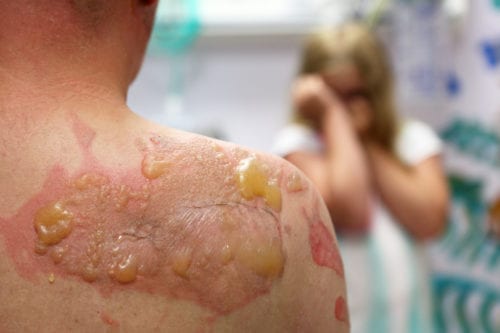
What is Pemphigus Vulgaris?
This blistering disorder occurs when the body’s immune system attacks itself – particularly the proteins in the uppermost layers of the epidermis. When this happens, painful blisters begin to form and may even cause certain parts of the dermis to fall off.
Our immune system usually works to protect us against foreign invaders, keeping us healthy and fighting off bacteria or viruses with antibodies. In an autoimmune disorder, these same antibodies turn on our own healthy system and begin to attack proteins within the epidermis and mucous membranes. Pemphigus Vulgaris occurs when antibodies target certain proteins responsible for binding the top layers of the epidermis together. This false attack creates blisters that require medical treatment.
Symptoms and risks associated with pemphigus vulgaris
The main symptom of this potentially life-threatening disorder involves red, painful blisters on various parts of the body – particularly on mucous membranes like the mouth and eyes. A general feeling of malaise may occur but the true tell-tale signs are these rupturing blisters that quickly turn into painful lesions.
Once they burst, the person is much more susceptible to infection. When left untreated, Pemphigus Vulgaris can take on the look and feel of a severe burn. This damaged patch of skin can weep and ooze, leaving the individual seriously exposed to all manner of bacteria.
Treatments and Probability of Pemphigus Vulgaris Occurring
Dermatologists deal with skin conditions and may be consulted at the first sign of skin blistering. This specialist doctor may make a physical examination in combination with a skin biopsy in order to determine which autoimmune blistering diseases you have and how to proceed with treatment. Some doctors may utilize a tactic called immunofluorescence – a process that chemically stains the antibodies within the skin sample.
This epidermal blistering disease usually affects adults and is rarely seen in children. Men and women are equally susceptible, however, anyone that has preexisting conditions may deteriorate more quickly without the proper treatment. If left untreated, Pemphigus Vulgaris has the likelihood of turning fatal.
Medical treatments for pemphigus vulgaris
After determining that the patient has pemphigus vulgaris, the doctor may prescribe certain oral antibiotics or other medication to deal with the symptoms and the root cause of the disease. Below are the most common treatments for this skin blistering disorder:
- Corticosteroids administered orally or intravenously through infusion therapy
- Antibiotics to decrease the likelihood of infection
- Wound care and adequate dressing for ruptured blisters and lesions
- Immunosuppressants to stop the incorrect attack of autoantibodies
- Intravenous Immunoglobulin as a replacement therapy
How common pemphigus vulgaris is and probability of contracting
A person may be more likely to develop pemphigus vulgaris if they exhibit or undergo one or more of the following factors or events:
- Genetic predisposition. Certain medical studies have shown that individuals with histocompatibility class II molecules in certain alleles are more at risk of developing PV.
- Routine use of certain medications. While rare, some individuals who have regularly taken blood pressure inhibitors, blood cleaning agents like penicillamine, rifampin, or various NSAIDs, developed pemphigus vulgaris as a result.
- Skin stress. UV burns, thermal burns, or extreme infections on the epidermis have been shown to trigger this skin disorder.
- Pre-existing conditions. Those who already have an autoimmune disorder – especially thymoma or myasthenia gravis – are in a higher-risk population.
- Age. Younger populations are less vulnerable than the middle-aged group, as the average onset sits between ages 50-60.
Long Term Effects and General Care
While undergoing treatment for pemphigus vulgaris, it’s critical that a person also take steps at home to stay as healthy as possible. The actual blisters certainly affect daily life and depending on where they form, may impact one’s ability to eat, sleep well, bathe normally, or participate in physical activity.
Keeping a sterile, clean environment is extremely important to avoid infection. Routinely cleaning and dressing lesions is a necessary step of each day. As regular activity may be limited, patients with PV should try to stay as healthy and fit as possible, while taking extra care of their mental health through meditation and other self-care practices.
Long term effects
If detected early, pemphigus vulgaris has a high likelihood of going into remission. However, the treatment plan and daily care can be taxing on the individual with the disease and their care partner.
Side effects from corticosteroids may include memory problems, swelling in the legs, mood swings, and high blood pressure. As an individual undergoes treatment, they may have to deal with the pain and irritation from blisters while also managing symptoms from the treatment plan.
In some cases, scarring can occur, leaving marks of the disease on the body for life. Other long term effects may include stress, lack of sleep, lost time at work, and other intangible things. Even if the disease goes into remission, the individual may experience difficulty and stress when assuming normal life again.
Be Proactive and Take Action
As with any autoimmune blistering disease, seeking medical help immediately is of the utmost importance. In order to receive the treatment you need, a dermatologist must first determine which blistering skin disorder is occurring before deciding how to move forward with your healthcare.
Upon noticing potential signs of pemphigus vulgaris, it’s crucial to seek help immediately. This autoimmune blistering disorder can quickly begin to impact daily life and grow life-threatening the longer it is left untreated.
UCF Health’s Orlando dermatologists, including Dr. Naveed Sami, use their skills and expertise to diagnose and treat even the rarest of skin conditions. They take the time to consider each patient’s entire health picture and devise effective treatment plans. In light of the recent global pandemic, we take pride in our sterile facilities and providing COVID updates for patients, so that our community stays active, safe, and healthy throughout this season.
